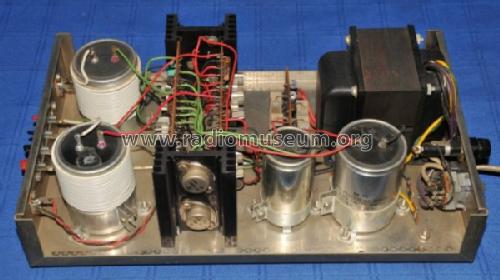Got the rehabbed ST-80 online today after replacing all the electrolytic caps with modern replacements from Digi Key. It sounds great. I listend to some classical for a while then some progressive rock on the Yamaha T-1 tuner and C-50 preamp. I can turn the vol up all the way and hear NO noise with no input now. Next will try the same rehab on the ST-120 that also needs new caps. The total cost was quite reasonable.
I removed the two caps on the right side and zip tied the new ones to the mounts. I left the two caps on the left in place as coil forms and zip tied the new caps to the old ones. The two circuit boards were removed and the electrolytics on each were also replaced.
Here is some info from the unofficial Dynaco site.
The Dynaco Stereo 80 is an all silicon transistor basic power amplifier for use with separate preamplifiers such as the Dynaco PAT-4 or PAT-5, or for use with tape recorders or tuners such as the FM-5 or AF-6, which have their own volume controls. The Stereo 80 contains two 40 watt amplifiers on one chassis with a common power supply.
The components of the Stereo 80 are of the highest quality to protect against failure, both now and for many years in the future. All parts are used conservatively with close tolerances to assure continued proper operation, and etched circuit modules have been pretested under actual use conditions to ensure that every unit, after assembly, will meet the specifications normally associated only with laboratory prototypes.
The specifications of the Stereo 80 speak for themselves. The distortion and noise, up to levels well beyond those required to drive any conventional amplifier, are comparable to the finest tube designs while the high power distortion remains inaudible. Specifications do not reveal all the facets of superior audio performance, however. In use with varying program material, the Stereo 80 achieves its design goals of sonic ease and naturalness always sought but rarely achieved in solid state designs. There is remarkable clarity and an impression of direct contact with the original without the extra brightness or stridency which, unfortunately, is sometimes attributed to high fidelity sound, but rather there is an impression of limitless range and effortless handling of the highest power peaks.
Specifications:
Rated Power Output: 30 watts average continuous power per channel into 8 ohms, 20-20,000 Hz at less than 0.5% total harmonic distortion. Distortion reduces at lower power levels.
Power at Clipping, Single Channel, 1000 Hz, less than 1% distortion: 50 watts @ 8 ohms, 36 watts @ 4 ohms, 26 watts @ 16 ohms.
Intermodulation Distortion: Less than 0.5% at any power level up to 40 watts rms per channel into 8 ohms with any combination of test frequencies. Distortion reduces at lower power levels.
Half-Power Bandwidth: 20 watts per channel at less than 0.5% total harmonic distortion from 8 Hz to 50 KHz into 8 ohms.
Frequency Response: ±0.5 dB, 10 Hz to 50 KHz @ 1 watt into 8 ohms.
Noise: More than 90 dB below 40 watts output, full spectrum.
Channel Separation: Greater than 60 dB from 20 Hz to 20 KHz.
Input: 100,000 ohm load; 1.3 volts for 40 watts into 8 ohms.
Semiconductor Complement: 12 transistors; 10 diodes.
Size: 14" by 8" by 4" high.
Shipping Weight: 13 lbs.
Maximum Power Consumption: 35 watts quiescent; 250 watts maximum; 50/60 Hz, 100, 120, 220, or 240 VAC.
Designed by:
Ed Laurent
Year Introduced:
1969
Price:
$149.00 kit
$224.00 assembled
Comments:
A pared-down version of the Stereo 120, with 40 watts per channel, and an unregulated power supply.

1 comment:
Hi Paul,
I built this amp myself, and a Pat-4 pre, back in the late 1970s; I still have it, and its bigger brother, bought at a garage sale. They sound good.
You may remember me as your neighbor back in Chatham. I have tried to contact you before, to no avail.
I have fond memories of your radio shack up there on the 3rd floor. I learned a lot and still have a deep appreciation for radio and electronics, though I never got my license.
Indeed, I am trying to write about '50s radio scene and technology, in a novel I am working on, and would love to talk about same. Might you have time for a phone call sometime?
BTW, have you seen this: www.flicklives.com? You were a big fan, no?
john@jverity [dot] "calm"
Post a Comment